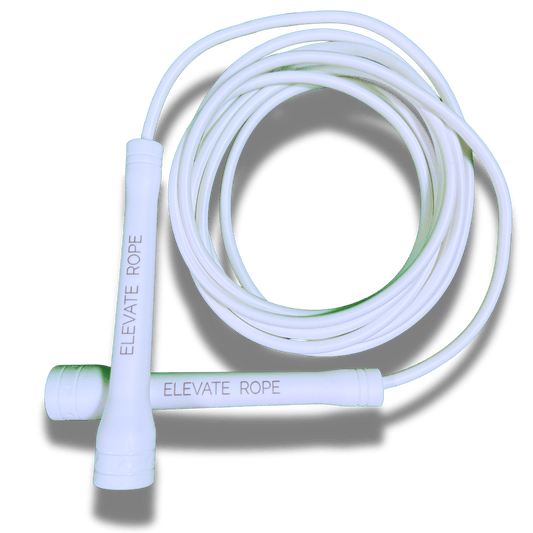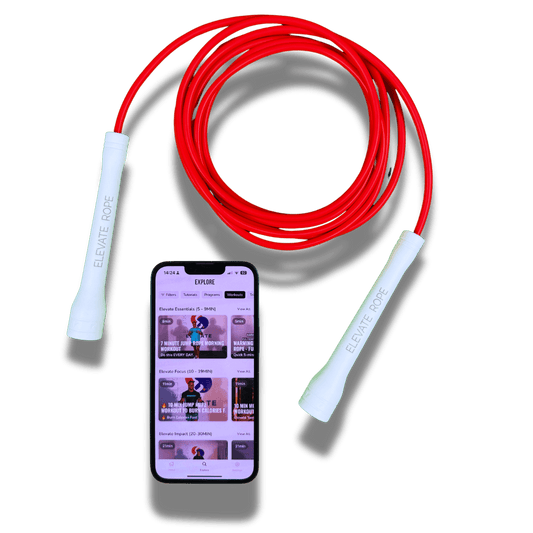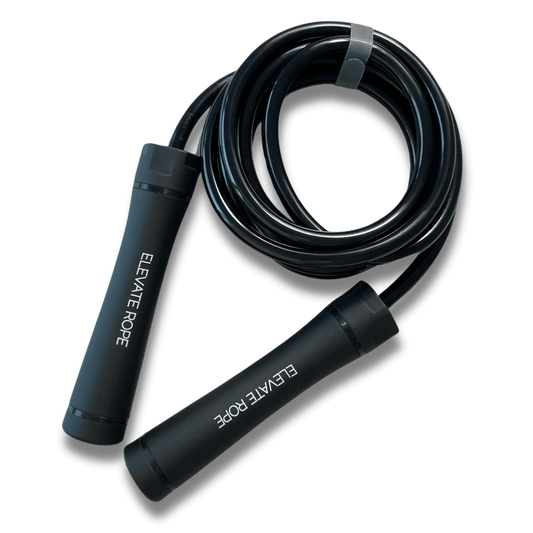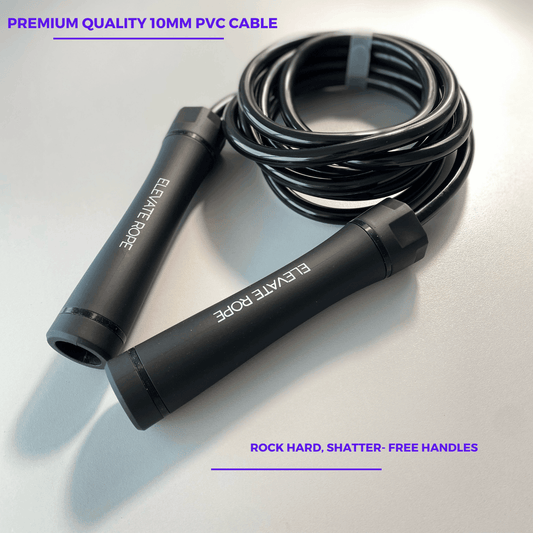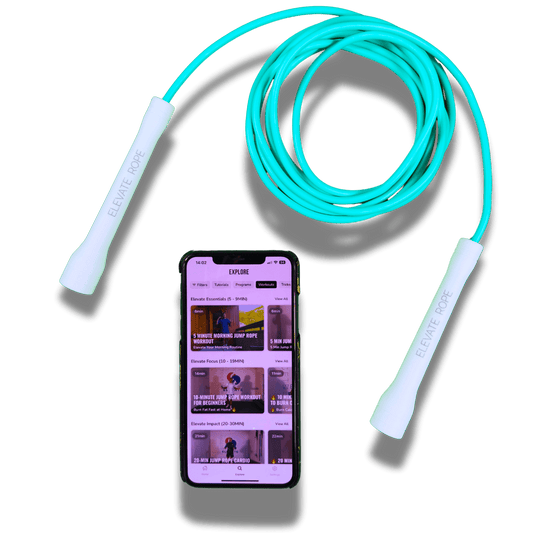5 Jump Rope Drills for Runners to Improve Endurance & Stride
Running is one of the purest forms of movement — all you need are shoes, space, and determination for real runners. But to run stronger, longer, and injury-free, you need more than just miles.
That’s where jump rope comes in.
More and more runners are discovering the power of adding jump rope training to their weekly routine. It’s simple, low-impact, and incredibly effective for building stamina, improving stride rhythm, and increasing agility.
Whether you’re a beginner training for your first 5K or an experienced marathoner chasing a new personal record, learning how to integrate jump rope into your running routine will take your performance to the next level.

Why Jump Rope Training Works for Runners
Jump rope and running share one essential foundation: rhythm.
Every stride and every jump rely on precise timing and coordination. By training with a rope, you enhance the same movement patterns that make you a faster, more efficient runner. Here’s why:
- Improved cadence: Jump rope naturally helps you hit an ideal running cadence of 170–180 steps per minute.
- Shorter ground contact time: Each jump conditions your body to spring off the ground faster — improving stride efficiency.
- Increased lower-leg strength: Rope training builds the calves, ankles, and feet — the same muscles that keep runners stable.
- Enhanced cardiovascular fitness: It challenges your aerobic and anaerobic systems simultaneously, building stamina and recovery.
- Better balance and posture: A good rope rhythm requires upright alignment, teaching you to maintain a strong, tall running posture.
“A few minutes of jump rope gives me the same intensity as a tempo run — but without pounding my knees.”
— Elevate Rope Athlete
The Benefits of Jump Rope for Runners
Jump rope is more than a warm-up — it’s a performance-enhancing tool. Here are the top benefits for every type of runner.
1. Builds Endurance Efficiently
A ten-minute rope session can deliver the same cardiovascular benefits as a thirty-minute jog. It trains your heart, lungs, and muscles to perform better under fatigue — all while keeping training time short.
2. Improves Running Cadence
Runners with higher cadence move more efficiently and reduce injury risk. Jump rope naturally encourages quick, light steps that transfer directly to your running rhythm.
3. Strengthens Feet and Ankles
Most running injuries — from shin splints to plantar fasciitis — start with weak feet. Jump rope strengthens your stabilizing muscles and tendons, improving foot control and durability.
4. Enhances Stride Power and Elasticity
Each jump develops your body’s stretch-shortening cycle — the mechanism that gives you spring and rebound. The result: smoother take-offs, faster strides, and better energy return.
5. Boosts Agility and Focus
Rope work forces coordination between your mind and body. It sharpens concentration and reaction time — vital during quick pace changes or uneven terrain.

The Best Jump Rope Drills for Runners
The following drills target the key movement patterns that improve endurance, agility, and stride rhythm. Add them into your warm-ups, rest days, or strength sessions.
1. Alternating Foot Step (Runner’s Rhythm)
Purpose: Teaches rhythm and cadence control.
How: Jump lightly, alternating feet like a light jog. Land softly on your forefoot.
Duration: 3 sets × 60 seconds (20 seconds rest).
Coaching cue: Keep elbows close and wrists relaxed — let the rope do the work.
2. Side-to-Side Jumps
Purpose: Builds lateral stability and hip control.
How: Hop side to side over an invisible line while maintaining steady rope turns.
Duration: 3 sets × 45 seconds (15 seconds rest).
Why it matters: Runners often neglect side-to-side motion — this drill strengthens stabilizers for downhill control and cornering.
3. Double-Unders
Purpose: Improves reactivity and leg power.
How: Jump once and turn the rope twice before landing.
Duration: 5 sets × 10 reps (30 seconds rest).
Pro tip: Keep jumps low — the goal is speed and precision, not height.
4. High-Knee Rope Steps
Purpose: Builds hip drive and core strength for powerful strides.
How: Lift your knees toward hip height with every turn.
Duration: 4 sets × 30 seconds (15 seconds rest).
Why it helps: Strengthens hip flexors — essential for sprint finishes and hill running.
5. Single-Leg Jumps
Purpose: Develops balance and equal leg strength.
How: Jump on one foot for 20 seconds, switch sides.
Duration: 3 rounds per leg.
Why it matters: Runners spend most of their stride on one foot — single-leg jumps mimic that control.
6. Skater Bounds With Rope
Purpose: Improves lateral power and landing control.
How: Jump rope while hopping side to side like a speed skater.
Duration: 3 sets × 20 seconds (20 seconds rest).
Bonus: Engages glutes, hamstrings, and stabilizers for powerful drive-offs.
👉 Want to learn more rope drills?
Check out our Jump Rope Workout Plans & Challenges →
⏱️ 15-Minute Jump Rope Workout for Runners
Short, efficient, and beginner-friendly — this full routine builds endurance, coordination, and leg strength fast.
Warm-Up (3 minutes)
- Easy bounce step – 45s
- Alternating foot step – 60s
- Side swings – 30s
- High knees – 45s
Main Set (10 minutes)
- Alternating Foot Step – 60s
- High-Knee Rope Steps – 45s
- Side-to-Side Jumps – 45s
- Double-Unders – 30s
- Single-Leg Jumps – 30s/leg
- Skater Bounds – 30s
- Rest – 30s, then repeat set twice
Cooldown (2 minutes)
- Slow bounce step – 60s
- Standing calf + hamstring stretch – 60s
Equipment tip:
Use a beaded rope for beginners (great feedback + control).
Switch to a speed rope for faster cadence and high-intensity drills.
Common Mistakes (and How to Fix Them)
Even runners with strong legs make these errors when learning jump rope. Here’s how to correct them for faster progress.
1. Jumping Too High
High jumps waste energy and break rhythm.
Fix: Stay low — just 2–3 cm off the ground. Focus on quick, controlled hops.
2. Landing Flat-Footed
This leads to shin splints and knee stress.
Fix: Stay light on your forefoot with knees slightly bent for natural shock absorption.
3. Using the Wrong Rope Size
If your rope is too long, it slows you down; too short, it catches your toes.
Fix: Step on the middle of the rope — handles should reach your armpits.
4. Skipping Warm-Up and Recovery
Cold ankles and calves = higher injury risk.
Fix: Always warm up 2–3 minutes before, and stretch or roll calves afterward.
5. Doing Too Much Too Soon
Adding 20-minute rope sessions overnight causes calf fatigue or tendon pain.
Fix: Start with 5–10 minutes, 2–3× per week. Build gradually as your coordination improves.
6. Training Without a Plan
Random sessions = random results.
Fix: Follow a structured plan like the Elevate 14-Day Challenge → to stay consistent and measure progress.
Remember: Light feet = strong runner. Every clean jump builds stability and rhythm for your stride.

How to Add Rope Training to Your Running Schedule
Here’s how to balance rope training with your runs for maximum performance.
Pre-Run Activation (3–5 minutes)
Use simple bounce steps and alternating foot jumps to prime your calves and hips.
→ Increases blood flow and coordination before runs.
Cross-Training Days (2–3× per week)
Replace short easy runs with 10–15 minutes of rope work.
→ Boosts stamina while reducing joint impact.
Post-Run Finishers (2–3 minutes)
After runs, finish with double-unders or high-knees to sharpen reactivity.
→ Builds durability and fast recovery legs.
Recovery Tip:
End every rope session with calf stretches and ankle circles. Consistent mobility work prevents tightness and fatigue.
Why Runners Love Rope Training
Runners who stick with jump rope notice:
- Better race rhythm — fewer sloppy strides and smoother pace control.
- Fewer injuries — stronger feet mean fewer breakdowns.
- Higher energy levels — short rope sessions trigger endorphins fast.
- Confidence boost — rope mastery feels empowering and fun.
Rope training turns endurance into a skill, not just effort.
You learn to control rhythm, timing, and breathing — three elements that define elite runners.
Final Takeaway: Jump Rope = Stronger, Smarter Running
Jump rope isn’t a gimmick — it’s a performance tool.
It builds the exact traits every runner needs: rhythm, endurance, agility, and focus.
Even ten minutes a day can transform your training.
You’ll feel lighter, move quicker, and recover faster — with less stress on your body.
So grab your rope, set your timer, and get ready to elevate your stride.
Because the best runners aren’t just fast — they’re rhythmically powerful.





